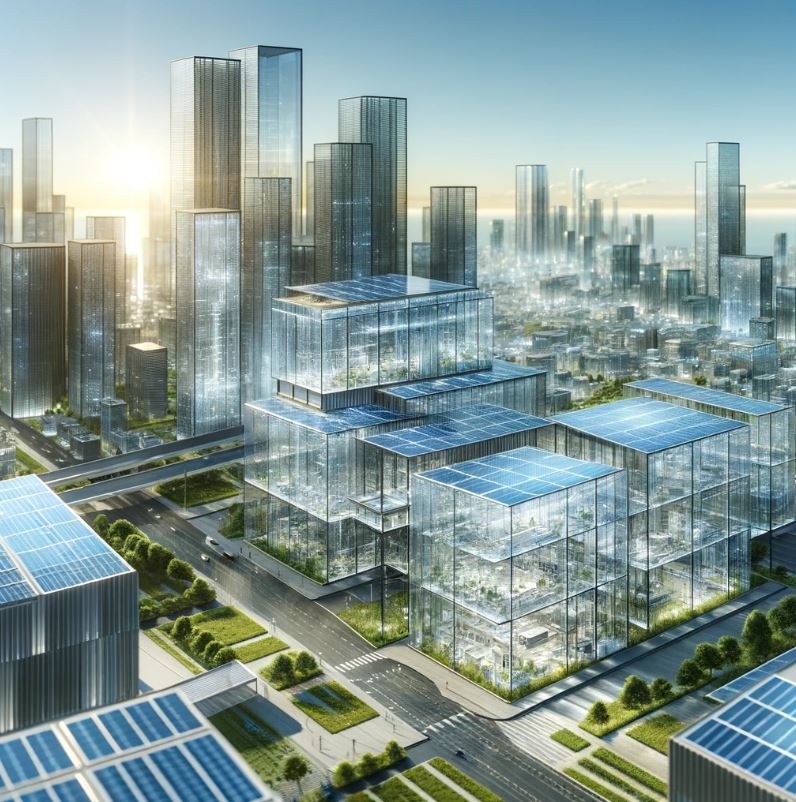Revolutionising Renewable Energy: The Emergence of Advanced Solar-Integrated Polycarbonate Panels
In the search for sustainable energy solutions, the development of advanced solar-integrated polycarbonate panels marks a significant milestone. These panels are at the forefront of merging the robustness of polycarbonate materials with the efficiency of solar photovoltaic (PV) technology. Unlike traditional roofing materials, these innovative panels serve a dual purpose: they provide a durable protective layer for homes while efficiently converting sunlight into electrical energy.
The integration of solar cells within these panels is a feat of engineering. It involves embedding high-efficiency photovoltaic cells into the polycarbonate material, creating a seamless and functional design. This integration ensures that the aesthetics of the home are maintained while harnessing the power of the sun. The efficiency of these panels is remarkable, often surpassing that of traditional solar panels, thanks to the advancements in photovoltaic technology and the inherent properties of polycarbonate that allow for better light transmission and durability.
Furthermore, the environmental impact of these panels is noteworthy. By enabling homeowners to generate clean, renewable energy, they significantly reduce reliance on fossil fuels, thus contributing to a reduction in greenhouse gas emissions. This technology is a beacon of hope in the battle against climate change, demonstrating how innovative solutions can harmonize the needs of humanity with the well-being of our planet.
💡 Key Takeaway: Advanced solar-integrated polycarbonate panels represent a ground-breaking development in sustainable energy, combining the durability of polycarbonate materials with the efficiency of solar PV technology. These panels serve a dual purpose: providing a robust protective layer for homes while efficiently converting sunlight into electrical energy, thus significantly reducing reliance on fossil fuels and aiding in the fight against climate change.
Building a Greener Future: Energy-Efficient Homes with Integrated Solar Solutions
The concept of energy-efficient homes has been transformed with the integration of solar-integrated polycarbonate roofing. This innovative approach to home design is changing the way we think about energy consumption and sustainability. Homes equipped with these roofing systems are not just shelters but are mini power stations, capable of producing their own electricity.
These energy-efficient homes are designed to maximise the use of natural resources while minimizing environmental impact. The solar-integrated polycarbonate panels play a crucial role in this design philosophy. By converting sunlight into electricity, these homes can meet a significant portion of their energy needs independently. This reduces their reliance on the grid and lowers electricity bills substantially. For example, a study involving a suburban home equipped with solar-integrated polycarbonate roofing showed a dramatic reduction in energy costs, with savings accumulating over time.
The benefits extend beyond individual households. As more homes adopt this technology, the cumulative effect on energy conservation can be significant. It represents a major step towards building sustainable communities and reducing the overall carbon footprint of residential areas.
💡 Key Takeaway: Solar-integrated polycarbonate roofing is revolutionizing home energy efficiency, transforming houses into self-sufficient power stations. This technology not only allows homes to significantly reduce grid dependence and lower electricity costs, but also plays a vital role in minimizing environmental impact. As more households adopt this approach, it paves the way for more sustainable communities and a substantial reduction in the carbon footprint of residential areas.
The Fusion of Form and Function: Aesthetic Innovations in Solar Roofing
The evolution of solar-integrated polycarbonate roofing has brought about a transformation in architectural design. No longer are solar panels merely functional elements; they have become integral components of a home's aesthetic appeal. The latest designs in polycarbonate roofing are a testament to this change, offering a variety of styles, colours, and finishes that complement the architectural vision of any home.
These innovative panels merge the practicality of energy generation with the beauty of modern design. They are available in a range of textures and hues, allowing architects and homeowners to choose options that best suit their style preferences. The flexibility in design means that these panels can be integrated into various architectural styles, from contemporary to traditional, without compromising the visual appeal of the structure.
Moreover, the sleek and modern look of these panels adds a distinctive character to homes, often enhancing their curb appeal and market value. This blend of form and function is a significant development in the world of sustainable architecture, where the need for energy efficiency is balanced with the desire for aesthetic elegance.
💡 Key Takeaway: The advent of solar-integrated polycarbonate roofing represents a significant shift in architectural design, blending energy efficiency with aesthetic appeal. These panels offer diverse styles, colours, and finishes, enabling a seamless integration into various architectural themes without sacrificing visual attractiveness. This innovation not only enhances the curb appeal and market value of homes but also marks a pivotal advancement in sustainable architecture, harmoniously combining practicality with modern design elegance.
Long-Term Sustainability: Unveiling the Durability and Maintenance of Solar Roofs
The long-term benefits of solar-integrated polycarbonate roofing are as impressive as their immediate advantages. These roofing systems are designed to endure the test of time, providing a sustainable and cost-effective solution for homeowners. The durability of polycarbonate material, known for its resistance to impact, weather, and UV radiation, makes it an ideal choice for roofing applications. When combined with solar cells, the result is a robust roofing system that can withstand diverse environmental conditions while continuously generating energy.
Maintenance is a key factor in the longevity of any roofing system, and solar-integrated polycarbonate roofs are no exception. However, the maintenance required for these roofs is surprisingly minimal. The non-corrosive and weather-resistant properties of polycarbonate ensure that the panels remain effective and aesthetically pleasing for years. Routine cleaning to remove dust and debris is often all that is needed to keep these panels functioning at optimal levels.
This combination of durability and low maintenance makes solar-integrated polycarbonate roofing a wise investment for homeowners. The initial cost is offset by the long-term savings in energy bills and maintenance expenses, making it an economically viable option for those seeking a sustainable living solution.
Economic and Environmental Synergy: The Financial Upside of Solar Roofs
The decision to invest in solar-integrated polycarbonate roofing is not just an environmentally conscious choice but also a financially savvy one. Homeowners who opt for this innovative roofing solution can benefit from various economic advantages, including potential government incentives and significant savings on energy bills.
Government incentives such as tax credits, rebates, and grants are often available to encourage the adoption of renewable energy technologies. These incentives can substantially reduce the initial investment cost of installing solar-integrated roofing systems. Additionally, the energy generated by these systems can lead to considerable savings on electricity bills. Over time, the reduction in energy costs can result in a return on investment that far exceeds the initial outlay.
Furthermore, the increased energy independence provided by these systems can shield homeowners from fluctuating energy prices, adding an extra layer of financial security. In some regions, surplus energy generated by these solar roofs can be sold back to the grid, creating an additional income stream for homeowners.
These economic benefits, combined with the environmental advantages of using renewable energy, make solar-integrated polycarbonate roofing an appealing option for those looking to invest in a sustainable and cost-effective home improvement.
Emerging Technologies in Energy Storage: Enhancing the Efficiency of Solar Roofs
The evolution of solar-integrated polycarbonate roofing is closely linked with advancements in energy storage technologies. The integration of home battery systems and other storage solutions with solar roofs is a critical development in maximizing the potential of renewable energy. These storage systems enable homeowners to store excess energy generated during peak sunlight hours and use it during periods of low sunlight or at night.
Modern energy storage technologies are becoming more efficient, affordable, and compact, making them an ideal complement to solar roofing systems. They not only enhance the self-sufficiency of homes but also contribute to the stabilization of the local power grid by reducing the demand during peak hours.
The synergy between solar-integrated roofing and energy storage solutions is a cornerstone in the transition to a more sustainable energy future. As these technologies continue to evolve, they will play a pivotal role in enabling homes to become fully energy-independent and significantly reduce their environmental impact.
Building Tomorrow Today: Eco-Friendly Construction Practices with Solar Roofing
Architects and builders are increasingly recognizing the importance of incorporating sustainable technologies into their designs, and solar-integrated polycarbonate roofing is at the forefront of this movement. This roofing solution represents a significant advancement in eco-friendly construction practices, offering a practical and aesthetically pleasing way to integrate renewable energy into residential and commercial buildings.
The adoption of these roofing systems is a reflection of a growing commitment to environmental stewardship within the construction industry. By choosing materials and technologies that have a lower environmental impact, architects and builders are not only meeting the current demand for sustainable living spaces but are also setting new standards in eco-friendly construction.
This approach goes beyond the use of renewable energy. It encompasses a holistic view of sustainability, where every aspect of construction, from materials to design, is aligned with the goal of reducing environmental impact. Solar-integrated polycarbonate roofing is a prime example of this philosophy, offering a durable, efficient, and visually appealing solution that contributes to the creation of environmentally responsible buildings.
Navigating the Future: Anticipating Trends in Solar Roofing Innovations
As we look to the future, the field of solar-integrated polycarbonate roofing is poised for further advancements. Emerging technologies and materials are set to enhance the efficiency and functionality of these systems. Researchers are exploring new photovoltaic materials that could increase the conversion efficiency of solar cells, making solar roofs even more productive.
Additionally, there is a growing interest in integrating smart technology with solar roofing systems. This includes the development of intelligent monitoring systems that can optimize energy production and usage, as well as predictive maintenance technologies that can extend the lifespan of the roofing system.
The future trends in solar-integrated roofing also point towards greater customization and flexibility in design. Advances in manufacturing techniques may allow for more bespoke solutions, catering to the specific aesthetic and functional needs of individual homes and buildings.
As these innovations unfold, solar-integrated polycarbonate roofing is set to become an even more integral part of sustainable living, further cementing its role as a key player in the transition to a greener, more energy-efficient future.

